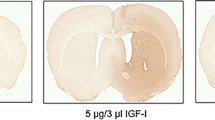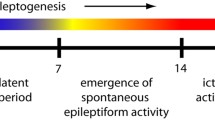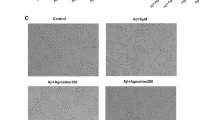Abstract
Insulin-like growth factor I (IGF-I) has been shown to act as a neuroprotectant both in in vitro studies and in in vivo animal models of ischemia, hypoxia, trauma in the brain or the spinal cord, multiple and amyotrophic lateral sclerosis, Alzheimer’s and Parkinson’s disease. In the present study, we investigated the neuroprotective potential of IGF-I in the “kainic acid-induced degeneration of the hippocampus” model of temporal lobe epilepsy. Increased cell death—as detected by FluoroJade B staining—and extensive cell loss—as determined by cresyl violet staining—were observed mainly in the CA3 and CA4 areas of the ipsilateral and contralateral hippocampus, 7 days following intrahippocampal administration of kainic acid. Kainic acid injection also resulted in intense astrogliosis—as assessed by the number of glial fibrillary acidic protein (GFAP) immunopositive cells—in both hemispheres, forming a clear astroglial scar ipsilaterally to the injection site. Heat-shock protein 70 (Hsp70) immunopositive cells were also observed in the ipsilateral dentate gyrus (DG) following kainic acid injection. When IGF-I was administered together with kainic acid, practically no signs of degeneration were detected in the contralateral hemisphere, while in the ipsilateral, there was a smaller degree of cell loss, reduced number of FluoroJade B-stained cells, decreased reactive gliosis and fewer Hsp70-positive cells. Our present results extend further the cases in which IGF-I is shown to exhibit neuroprotective properties in neurodegenerative processes in the CNS.





Similar content being viewed by others

Abbreviations
- AP:
-
Antero-posterior axis
- BDNF:
-
Brain derived neurotrophic factor
- CA1:
-
Field 1 of Ammon’s horn
- CA2:
-
Field 2 of Ammon’s horn
- CA3:
-
Field 3 of Ammon’s horn
- CA4:
-
Field 4 of Ammon’s horn
- CTR:
-
Control sham-operated
- DG:
-
Dentate gyrus
- GFAP:
-
Glial fibrillary acidic protein
- Hsp70:
-
Heat-shock protein 70
- IGF-I:
-
Insulin-like growth factor I
- IGF-II:
-
Insulin-like growth factor II
- IGF-IR:
-
Type I IGF receptor
- KA:
-
Kainic acid
- NGS:
-
Normal goat serum
- NRS:
-
Normal rabbit serum
- PBS:
-
Phosphate buffer saline
- PBT:
-
Phosphate buffer saline containing 0.4% Triton X-100
- S:
-
Subiculum
- SEM:
-
Standard error of the mean
- TLE:
-
Temporal lobe epilepsy
References
Aberg ND, Brywe KG, Isgaard J (2006) Aspects of growth hormone and insulin-like growth factor-I related to neuroprotection, regeneration, and functional plasticity in the adult brain. Sci World J 6:53–80
Acharya MM, Hattiangady B, Shetty AK (2008) Progress in neuroprotective strategies for preventing epilepsy. Prog Neurobiol 84:363–404
Adams B, Sazgar M, Osehobo P, Van der Zee CE, Diamond J, Fahnestock M, Racine RJ (1997) Nerve growth factor accelerates seizure development, enhances mossy fiber sprouting, and attenuates seizure-induced decreases in neuronal density in the kindling model of epilepsy. J Neurosci 17:5288–5296
Akama KT, Van Eldik LJ (2000) Beta-amyloid stimulation of inducible nitric-oxide synthase in astrocytes is interleukin-1beta- and tumor necrosis factor-alpha (TNFalpha)-dependent, and involves a TNFalpha receptor-associated factor- and NFkappaB-inducing kinase-dependent signaling mechanism. J Biol Chem 275:7918–7924
Akbar MT, Wells DJ, Latchman DS, de Belleroche J (2001) Heat shock protein 27 shows a distinctive widespread spatial and temporal pattern of induction in CNS glial and neuronal cells compared to heat shock protein 70 and caspase 3 following kainite administration. Mol Brain Res 93:148–163
Armstrong JN, Plumier JC, Robertson HA, Currie RW (1996) The inducible 70,000 molecular/weight heat shock protein is expressed in the degenerating dentate hilus and piriform cortex after systemic administration of kainic acid in the rat. Neuroscience 74:685–693
Beilharz EJ, Russo VC, Butler G, Baker NL, Connor B, Sirimanne ES, Dragunow M, Werther GA, Gluckman PD, Williams CE, Scheepens A (1998) Co-ordinated and cellular specific induction of the components of the IGF/IGFBP axis in the rat brain following hypoxic-ischemic injury. Mol Brain Res 59:119–134
Ben-Ari Y (1985) Limbic seizure and brain damage produced by kainic acid: mechanisms and relevance to human temporal lobe epilepsy. Neuroscience 14:375–403
Binder DK, Steinhäuser C (2006) Functional changes in astroglial cells in epilepsy. Glia 54:358–368
Binder DK, Croll SD, Gall CM, Scharfman HE (2001) BDNF and epilepsy: too much of a good thing? Trends Neurosci 24:47–53
Bluthé RM, Frenois F, Kelley KW, Dantzer R (2005) Pentoxifylline and insulin-like growth factor-I (IGF-I) abrogate kainic acid-induced cognitive impairment in mice. J Neuroimmunol 169:50–58
Burda J, Danielisová V, Némethová M, Gottlieb M, Kravcuková P, Domoráková I, Mechírová E, Burda R (2009) Postconditioning and anticonditioning: possibilities to interfere to evoked apoptosis. Cell Mol Neurobiol 29:821–825
Chesik D, Wilczak N, De Keyser J (2007) The insulin-like growth factor system in multiple sclerosis. Int Rev Neurobiol 79:203–226
Chesik D, De Keyser J, Wilczak N (2008) Insulin-like growth factor system regulates oligodendroglial cell behavior: therapeutic potential in CNS. J Mol Neurosci 35:81–90
Croll SD, Goodman JH, Scharfman HE (2004) Vascular endothelial growth factor (VEGF) in seizures: a double-edged sword. Adv Exp Med Biol 548:57–68
de Lanerolle NC, Lee TS (2005) New facets of the neuropathology and molecular profile of human temporal lobe epilepsy. Epilepsy Behav 7:190–203
de Pablo F, de la Rosa EJ (1995) The developing CNS: a scenario for the action of proinsulin, insulin and insulin-like growth factors. Trends Neurosci 18:143–150
Di Giovanni S, Movsesyan V, Ahmed F, Cernak I, Schinelli S, Stoica B, Faden AI (2005) Cell cycle inhibition provides neuroprotection and reduces glial proliferation and scar formation after traumatic brain injury. Proc Natl Acad Sci USA 102:8333–8338
Ebert AD, Beres AJ, Barber AE, Svendsen CN (2008) Human neural progenitor cells over-expressing IGF-1 protect dopamine neurons and restore function in a rat model of Parkinson’s disease. Exp Neurol 209:213–223
Fernandez AM, Carro EM, Lopez-Lopez C, Torres-Aleman I (2005) Insulin-like growth factor I treatment for cerebellar ataxia: addressing a common pathway in the pathological cascade? Brain Res Rev 50:134–141
Gluckman PD, Guan J, Williams C, Scheepens A, Zhang R, Bennet L, Gunn A (1998) Asphyxial brain injury—the role of the IGF system. Mol Cell Endocrinol 140:95–99
Górecki DC, Beresewicz M, Zabłocka B (2007) Neuroprotective effects of short peptides derived from the insulin-like growth factor 1. Neurochem Int 51:451–458
Guan J, Bennet L, Gluckman PD, Gunn AJ (2003) Insulin-like growth factor-1 and post-ischemic brain injury. Prog Neurobiol 70:443–462
Heinemann U, Gabriel S, Jauch R, Schulze K, Kivi A, Eilers A, Kovacs R, Lehmann TN (2000) Alterations of glial cell function in temporal lobe epilepsy. Epilepsia 4:185–189
Heneka MT, Sharp A, Klockgether T, Gavrilyuk V, Feinstein DL (2000) The heat shock response inhibits NF-kappaB activation, nitric oxide synthase type 2 expression, and macrophage/microglial activation in brain. J Cereb Blood Flow Metab 20:800–811
Hopkins KJ, Wang G, Schmued LC (2000) Temporal progression of kainic acid induced neuronal and myelin degeneration in the rat forebrain. Brain Res 864:69–80
Hung KS, Tsai SH, Lee TC, Lin JW, Chang CK, Chiu WT (2007) Gene transfer of insulin-like growth factor-I providing neuroprotection after spinal cord injury in rats. J Neurosurg Spine 6:35–46
Jones JI, Clemmons DR (1995) Insulin-like growth factors and their binding proteins: biological actions. Endocr Rev 16:3–34
Kanter-Schlifke I, Georgievska B, Kirik D, Kokaia M (2007) Seizure suppression by GDNF gene therapy in animal models of epilepsy. Mol Ther 15:1106–1113
Kaspar BK, Llabó J, Sherkat N, Rothstein JD, Gage FH (2003) Retrograde viral delivery of IGF-1 prolongs survival in a mouse ALS model. Science 301:839–842
Kazanis I, Bozas E, Philippidis H, Stylianopoulou F (2003) Neuroprotective effects of insulin-like growth factor-I (IGF-I) following a penetrating brain injury in rats. Brain Res 991:34–45
Kazanis I, Giannakopoulou M, Philippidis H, Stylianopoulou F (2004) Alterations in IGF-I, BDNF and NT-3 levels following experimental brain trauma and the effect of IGF-I administration. Exp Neurol 186:221–234
Lähteinen S, Pitkänen A, Saarelainen T, Nissinen J, Koponen E, Castrén E (2002) Decreased BDNF signalling in transgenic mice reduces epileptogenesis. Eur J Neurosci 15:721–734
Laurberg S (1979) Commissural and intrinsic connections of the rat hippocampus. J Comp Neurol 184:685–708
Lee JY, Park J, Kim YH, Kim DH, Kim CG, Koh JY (2000) Induction by synaptic zinc of heat shock protein-70 in hippocampus after kainate seizures. Exp Neurol 161:433–441
Li W, Xia J, Sun GY (1999) Cytokine induction of iNOS and sPLA2 in immortalized astrocytes (DITNC): response to genistein and pyrrolidine dithiocarbamate. J Interferon Cytokine Res 19:121–127
Li S, Saragovi HU, Nedev H, Zhao C, Racine RJ, Fahnestock M (2005) Differential actions of nerve growth factor receptors TrkA and p75NTR in a rat model of epileptogenesis. Mol Cell Neurosci 29:162–172
Liu Z, D’Amore PA, Mikati M, Gatt A, Holmes GL (1993) Neuroprotective effect of chronic infusion of basic fibroblast growth factor on seizure-associated hippocampal damage. Brain Res 626:335–338
Liu XF, Fawcett JR, Hanson LR, Frey WH 2nd (2004) The window of opportunity for treatment of focal cerebral ischemic damage with noninvasive intranasal insulin-like growth factor-I in rats. J Stroke Cerebrovasc Dis 13:16–23
Lothman EW, Collins RC (1981) Kainic acid induced limbic seizures: metabolic, behavioral, electroencephalographic and neuropathological correlates. Brain Res 218:299–318
Maglóczky Z, Freund TF (1995) Delayed cell death in the contralateral hippocampus following kainate injection into the CA3 subfield. Neuroscience 66:847–860
Martin D, Miller G, Rosendahl M, Russell DA (1995) Potent inhibitory effects of glial derived neurotrophic factor against kainic acid mediated seizures in the rat. Brain Res 683:172–178
Mitchell JD, Wokke JH, Borasio GD (2007) Recombinant human insulin-like growth factor I (rhIGF-I) for amyotrophic lateral sclerosis/motor neuron disease. Cochrane Database Syst Rev 4: CD002064
Musarò A, Dobrowolny G, Rosenthal N (2007) The neuroprotective effects of a locally acting IGF-1 isoform. Exp Gerontol 42:76–80
Oberheim NA, Tian GF, Han X, Peng W, Takano T, Ransom B, Nedergaard M (2008) Loss of astrocytic domain organization in the epileptic brain. J Neurosci 28:3264–3276
Ohlsson M, Mattsson P, Wamil BD, Hellerqvist CG, Svensson M (2004) Macrophage stimulation using a group B-streptococcus exotoxin (CM101) leads to axonal regrowth in the injured optic nerve. Restor Neurol Neurosci 22:33–41
Park E, Bell JD, Baker AJ (2008) Traumatic brain injury: can the consequences be stopped? CMAJ 178:1163–1170
Paxinos G, Watson C (1986) The rat brain in stereotaxic coordinates, 2nd edn. Academic Press, San Diego
Pitkänen A (2002) Efficacy of current antiepileptics to prevent neurodegeneration in epilepsy models. Epilepsy Res 50:141–160
Ridet JL, Malhotra SK, Privat A, Gage FH (1997) Reactive astrocytes: cellular and molecular cues to biological function. Trends Neurosci 20:570–577
Sandberg Nordqvist AC, von Holst H, Holmin S, Sara VR, Bellander BM, Schalling M (1996) Increase of insulin-like growth factor (IGF)-1 binding protein-2 and -4 mRNAs following cerebral contusion. Mol Brain Res 38:285–293
Schmued LC, Albertson C, Slikker W Jr (1997) Fluoro-Jade: a novel fluorochrome for the sensitive and reliable histochemical localization of neuronal degeneration. Brain Res 751:37–46
Seifert G, Schilling K, Steinhäuser C (2006) Astrocyte dysfunction in neurological disorders: a molecular perspective. Nat Rev Neurosci 7:194–206
Shetty AK, Turner DA (1999) Vulnerability of the dentate gyrus to aging and intracerebroventricular administration of kainic acid. Exp Neurol 158:491–503
Tokumitsu T, Mancuso A, Weinstein PR, Weiner MW, Naruse S, Maudsley AA (1997) Metabolic and pathological effects of temporal lobe epilepsy in rat brain detected by proton spectroscopy and imaging. Brain Res 744:57–67
Torres-Aleman I (2007) Targeting insulin-like growth factor-1 to treat Alzheimer’s disease. Expert Opin Ther Targets 11:1535–1542
Unsain N, Nuñez N, Anastasía A, Mascó DH (2008) Status epilepticus induces a TrkB to p75 neurotrophin receptor switch and increases brain-derived neurotrophic factor interaction with p75 neurotrophin receptor: an initial event in neuronal injury induction. Neuroscience 154:978–993
Voneida TJ, Vardaris RM, Fish SE, Reiheld CT (1981) The origin of the hippocampal commissure in the rat. Anat Rec 201:91–103
Walter HJ, Berry M, Hill DJ, Logan A (1997) Spatial and temporal changes in the Insulin-like growth factor (IGF) axis indicate autocrine/paracrine actions of IGF-I within wounds of the rat brain. Endocrinology 138:3024–3034
Wozniak DF, Stewart GR, Miller JP, Olney JW (1991) Age-related sensitivity to kainate neurotoxicity. Exp Neurol 114:250–253
Yao DL, West NR, Bondy CA, Brenner M, Hudson LD, Zhou J, Collins GH, Webster HD (1995) Cryogenic spinal cord injury induces astrocytic gene expression of insulin-like growth factor I and insulin-like growth factor binding protein 2 during myelin regeneration. J Neurosci Res 40:647–659
Acknowledgments
The study is part of the 03ED82 research project, implemented within the framework of the “Reinforcement Programme of Human Research Manpower” (PENED) and co-financed by National and Community Funds (25% from the Greek Ministry of Development-General Secretariat of Research and Technology and 75% from E.U.-European Social Fund).
Author information
Authors and Affiliations
Corresponding author
Rights and permissions
About this article
Cite this article
Miltiadous, P., Stamatakis, A. & Stylianopoulou, F. Neuroprotective Effects of IGF-I Following Kainic Acid-Induced Hippocampal Degeneration in the Rat. Cell Mol Neurobiol 30, 347–360 (2010). https://doi.org/10.1007/s10571-009-9457-4
Received:
Accepted:
Published:
Issue Date:
DOI: https://doi.org/10.1007/s10571-009-9457-4



